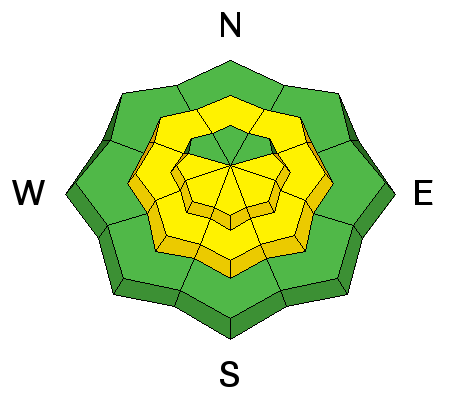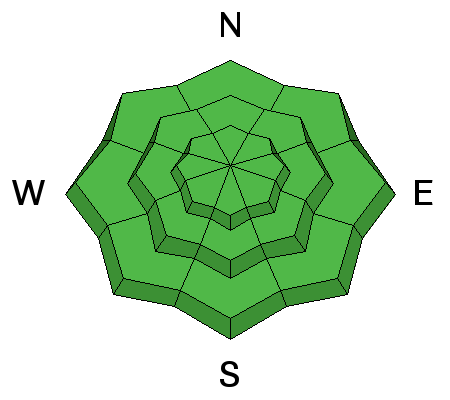25th Annual Black Diamond Fall Fundraising Party
Thursday, September 13; 6:00-10:00 PM; Black Diamond Parking Lot

25th Annual Black Diamond Fall Fundraising Party
Thursday, September 13; 6:00-10:00 PM; Black Diamond Parking Lot
| Advisory: Ogden Area Mountains | Issued by Evelyn Lees for Saturday - March 31, 2018 - 7:27am |
|---|
 |
special announcement The newest issue of the Powder Cloud, the newsletter of the Utah Avalanche Center, is hot off the digital presses. You can look at new and old issues of the Powder Cloud, other essays, and blogs in the menu above or click here.
The UAC Marketplace is still open. Our online marketplace still has deals on skis, packs, airbag packs, beacons, snowshoes, soft goods and much more. We have lift tickets for Snowbasin and Powder Mountain remaining. The tickets are discounted an additional 20%. Details and order information here. All proceeds from these go towards paying for avalanche forecasting and education! |
 |
current conditions Skies are overcast in the Ogden area mountains this morning, and temperatures have a large head start on yesterday – many stations are 7 to 10 degrees warmer than 24 hours ago – in the 30s at the mid elevations, and right around 40 at the lower elevations and trailheads. The west to southwesterly winds are breezy, averaging 10 to 15 mph at the mid elevations, with Mt Ogden averaging to 25 to 30 mph. There should be a window for spring corn today when the smooth, sunny slopes first soften and there is some soft, recrystallized powder on upper northerly facing slopes in wind-sheltered terrain. But there are widespread icy crusts, some which may not soften, so be prepared for hard, “slide for life” conditions in some terrain. Ice axes, crampons and ski crampons may be appropriate for steep objectives. Trail heads are melting out. |
 |
recent activity Wet loose activity was reported on upper elevation southeasterly facing slopes, above about 8,500'. Paige and Toby toured the periphery of Snowbasin Tuesday and their report can be found here. |
| type | aspect/elevation | characteristics |
|---|


|


|

LIKELIHOOD
 LIKELY
UNLIKELY
SIZE
 LARGE
SMALL
TREND
 INCREASING DANGER
SAME
DECREASING DANGER
|
|
description
With a warmer start to the day, the snow’s overnight night refreeze could be short lived today. It’s going to be a balance between wind, clouds and sun. Wind and clouds keep the snow cool. But if the sun comes out in full force where you are, the snow surface will rapidly heat and wet loose sluffs will become easy to trigger. Once the snow becomes wet and loose, it’s time to get off of and out from under steep slopes, and move to a cooler aspect or lower angle terrain. I've spent time this morning looking at this loop - a model and forecasting tool - of what they think the cloud cover will look like. You need to subtract 6 hours from the time to get our current Mountain Daylight time. Perhaps thicker clouds in the Ogden and Logan area mountains, with more breaks to the south? |
| type | aspect/elevation | characteristics |
|---|


|


|

LIKELIHOOD
 LIKELY
UNLIKELY
SIZE
 LARGE
SMALL
TREND
 INCREASING DANGER
SAME
DECREASING DANGER
|
|
description
The avalanche hazard is generally Low and avalanches are unlikely. But travel in avalanche terrain is never a completely safe game, so watch for the following issues on isolated features: Wind slabs: As yesterday’s Cottonwood avalanches indicate, there are places where wind drifts could be triggered, perhaps by a person – northerly and easterly facing slopes in the highest alpine terrain are the most suspect. These drifts would be failing on a graupel layer - so look for this layering by digging down a foot or so, and search for a layer of loose graupel beneath the surface snow or wind drifts. Persistent Deep Slab - If you’re wondering what happened to the Deep Slab avalanche problem, catch up with Mark’s great video summary of the current state of the snowpack below. While this was made in the Salt Lake area mountians, it still is relavant to the Ogden area moutains. The issue and the weak layers are not gone, rather they are currently dormant and avalanching on these deeper weak layers is unlikely. |
 |
weather A mild, westerly flow will be over northern Utah for the weekend. A weak weather disturbance will bring increasing clouds later today and tonight, but no snow. Temperatures will warm to around 50°F at 8,000’ today and in the upper 30s along the high ridge lines. The west to southwesterly wind are forecast to average in the 10 to 20 mph range at the mid elevations, and 25 to 35 mph at the highest elevation, with gusts occasionally reaching 50 mph. Mostly sunny skies on Sunday, with temperatures almost as warm. Next week is looking unsettled, with possible snow. |
| general announcements CLICK HERE FOR MORE GENERAL INFO AND FAQ The UAC has new support programs with Outdoor Research and Darn Tough. Support the UAC through your daily shopping. When you shop at Smith's, or online at Outdoor Research, REI, Backcountry.com, Darn Tough, Patagonia, NRS, Amazon, eBay a portion of your purchase will be donated to the FUAC. See our Donate Page for more details on how you can support the UAC when you shop. Benefit the Utah Avalanche Center when you buy or sell on eBay - set the Utah Avalanche Center as a favorite non-profit in your eBay account here and click on eBay gives when you buy or sell. You can choose to have your seller fees donated to the UAC, which doesn't cost you a penny This information does not apply to developed ski areas or highways where avalanche control is normally done. This advisory is from the U.S.D.A. Forest Service, which is solely responsible for its content. This advisory describes general avalanche conditions and local variations always occur. |